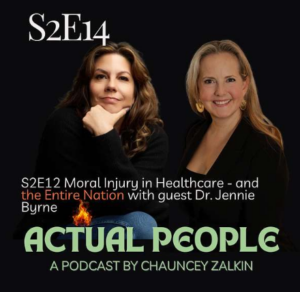Take-away III – Clinical Leadership
Give senior clinical leaders an authentic voice at the highest level of leadership, and give them the tools to translate the clinical voice to other systems like operations and finance.
Having gone through medical training myself, I can honestly say that medical training adds values that are difficult for non-healthcare providers to understand. Before medical school, I had a number of core values, like honesty, curiosity, and persistence. After medical school and residency, I added new values like responsibility, perfection, and kindness.
Clinicians like physicians and nurses feel highly responsible for their patients. Even though we cannot control our patients’ behavior, we feel that how they behave reflects upon us. For example, as a psychiatrist, if I had a patient who continued to use opioids despite being in substance use treatment with me, I would feel responsible for when they drove their car off the road and hit a pedestrian.
After my medical training, I felt that I had to be perfect 100% of the time. If for example, I called in a prescription with the wrong dose and the pharmacist called me to confirm, I would be highly embarrassed and ashamed that I made an error. I would ruminate on it all night long and worry about what would have happened if the pharmacist had not caught my error.
I also learned the importance of kindness. When I had a patient start crying in my office, I knew how important it was for me to sit with them quietly. I would offer them a tissue and put a hand on their shoulder. I would let them take their time before resuming the conversation.
I believe it is difficult for non-clinicians to understand how deeply-held these values are for clinicians. I believe it is difficult to understand how deeply it wounds when clinicians are forced to act against these values. Asking clinicians to rush and see more and more patients increases the risk of errors. Giving a clinician ten minutes to assess for depression creates a problem when the patient starts crying – what do you do? Bed shortages in the ER forces the physicians to discharge patients too soon, and if a patient leaves the ER and has a fatal heart attack at home – who is responsible?
The reason this is important to understand is that part of the solution to moral injury is to grow and develop the clinical leaders within the organization. Clinical leaders are uniquely positioned to understand the experience and value set of the other clinicians on the ground.
Many clinical leaders need help growing their operational and business skill set. In medical school, for example, physicians do not learn about finance. We do not learn about operational workflows; we do not learn about technology platforms. We train on medicine and bedside manner.
So, clinical leaders in most organizations need professional development. Spending the time and energy to train them in various parts of a healthcare organization, like operations, finance, technology, Human Resources, etc, reaps huge rewards. Clinical leaders who have done the clinical work themselves and “come up through the ranks” will already have the support and buy-in from their colleagues. But being a practicing clinician, they will lack the other skill sets. Luckily, clinical leaders tend to be quick learners and eager to fix the system.
Often, I have seen healthcare organizations choose clinical leaders who have completed an MD and perhaps a residency program, but who have not spent a significant amount of time in clinical practice. These leaders may have a strong business skill set, and perhaps an MBA. One of the biggest problems these leaders face is buy-in from the clinicians on the ground. The clinicians perceive these leaders as “other” or worse, “sell-outs,” who cannot empathize with their situation. These leaders will need to find ways to connect with the teams on the ground – doing some clinical work, or shadowing, or other ways to get closer to the day-to-day work.
What happens when you train clinical leaders about other parts of healthcare organizations?
The clinical leaders become translators of the system. They can translate the clinician experience on the ground to other parts of the organization. They can also translate the other parts of the organization back down to the clinician. This translation function is critical. Understanding the lingo and culture of different functional groups will enable the clinical leader to minimize moral injury to the providers and speak to them in a way that supports their values.
But learning how to translate is not enough.
The C-suite and other leadership levels within the healthcare organization must truly value and listen to the clinical leaders. It is not enough to invite the clinical leaders to the table for appearances. They must be valued and equal members of the leadership team.
There is evidence that clinical leadership matters. According to one study by Health Care Management Review, physician-led hospital systems performed higher in quality and efficiency of care compared to those led by non-physician managers.
I believe the reason that true clinical leadership works is because it minimizes moral injury amongst the providers on the ground. Give clinical leaders the tools and value to make meaningful change in the organization, and you will see the difference.







